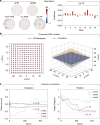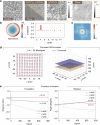Uncertainty-aware Fourier ptychography
- PMID: 40624000
- PMCID: PMC12234902
- DOI: 10.1038/s41377-025-01915-w
Uncertainty-aware Fourier ptychography
Abstract
Fourier ptychography (FP) offers both wide field-of-view and high-resolution holographic imaging, making it valuable for applications ranging from microscopy and X-ray imaging to remote sensing. However, its practical implementation remains challenging due to the requirement for precise numerical forward models that accurately represent real-world imaging systems. This sensitivity to model-reality mismatches makes FP vulnerable to physical uncertainties, including misalignment, optical element aberrations, and data quality limitations. Conventional approaches address these challenges through separate methods: manual calibration or digital correction for misalignment; pupil or probe reconstruction to mitigate aberrations; or data quality enhancement through exposure adjustments or high dynamic range (HDR) techniques. Critically, these methods cannot simultaneously address the interconnected uncertainties that collectively degrade imaging performance. We introduce Uncertainty-Aware FP (UA-FP), a comprehensive framework that simultaneously addresses multiple system uncertainties without requiring complex calibration and data collection procedures. Our approach develops a fully differentiable forward imaging model that incorporates deterministic uncertainties (misalignment and optical aberrations) as optimizable parameters, while leveraging differentiable optimization with domain-specific priors to address stochastic uncertainties (noise and data quality limitations). Experimental results demonstrate that UA-FP achieves superior reconstruction quality under challenging conditions. The method maintains robust performance with reduced sub-spectrum overlap requirements and retains high-quality reconstructions even with low bit sensor data. Beyond improving image reconstruction, our approach enhances system reconfigurability and extends FP's capabilities as a measurement tool suitable for operation in environments where precise alignment and calibration are impractical.
© 2025. The Author(s).
Conflict of interest statement
Conflict of interest: N.C. and E.Y.L. are inventors of a US patent application related to the work described in this paper. The other authors declare no competing interests.
Figures









References
-
- Li, S. et al. Far field synthetic aperture imaging via fourier ptychography with quasi plane wave illumination. Adv. Photonics Res.4, 2300180 (2023).
-
- Zhang, Q. et al. First realization of macroscopic Fourier ptychography for hundred-meter distance sub-diffraction imaging Print at 10.48550/arXiv.2310.14515 (2023).
-
- Li, S. et al. Snapshot macroscopic Fourier ptychography: far-field synthetic aperture imaging via illumination multiplexing and camera array acquisition. Adv. Imaging1, 011005 (2024).
LinkOut - more resources
Full Text Sources
Miscellaneous

